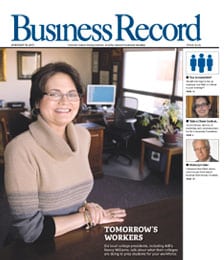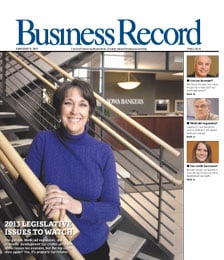Tight tourism budget spurs targeted, creative marketing

May is a prime month for travel planning, but a tight state budget for tourism promotion has created some challenges for Iowa tourism leaders. Unlike nearby states such as South Dakota and Minnesota, who have ramped up their television advertisements in Iowa this month, Iowa’s limited funding means that potential visitors will get their information about the state through print ads alone.
“Nobody ever has enough money for advertising,” said Nancy Landess, the manager of the Iowa Tourism Office, a division in the Iowa Department of Economic Development. “Certainly a priority for the tourism industry is to see more resources that will allow for a more multimedia campaign.”
A big boost to the state’s tourism budget isn’t expected to happen right away. Landess said her agency requested the same amount of funding from the Legislature for fiscal year 2006, which begins July 1. Back in the “golden age” of Iowa tourism in 2000 and 2001, Landess said the ITO’s budget was $6.2 million. Like all state agency budgets, it took a hit in 2001 when the economy started slipping, and it has continued to decline since then.
But Landess doesn’t dwell on her budget constraints, because tourism remains a big industry in Iowa, generating about $4.6 billion for the state’s economy. Plus, she has a couple of major travel trends on her side right now.
“The trend right now is that people are staying closer to home and taking several shorter trips instead of taking those two-week vacations,” Landess said. “And higher gas prices will support this trend of traveling closer to home.”
The ITO has always focused its advertising in areas within driving distance, which puts the state in a solid position as travelers plan shorter trips by car.
Landess said about 80 percent of tourists in Iowa come from surrounding states or from other parts of Iowa, with a tourist defined as anyone traveling more than 50 miles from home.
Landess said another thing working in favor of Iowa tourism is that new attractions are opening in the state, many of which have been financed by grants from the Vision Iowa and Community Attractions and Tourism programs. For example, the National Mississippi River Museum & Aquarium in Dubuque has exceeded its attendance goals by attracting more than 450,000 visitors since its opening in June 2003. Two Des Moines projects, the new Science Center of Iowa and the Iowa Hall of Pride, are among a growing list of new attractions also expected to boost tourism.
Cooperative advertising featuring specific locations, attractions or events has become an important part of the state’s tourism strategy to stretch advertising dollars further, Landess said.
“We partner with the industry for some cooperative advertising, which combines their promotional material and our state banner,” she said. “It also shows so many options for activities in Iowa. People might look at it and realize that they can do these three things close together and extend their stay.”
Still, several entertainment venues and local tourism groups have found it necessary to become more aggressive in marketing themselves to make up for what the Iowa State Tourism Office is no longer able to do.
“We’ve taken an aggressive marketing stance for about the last year and half,” said Terry Rich, CEO of the Blank Park Zoo. “As the state has decreased its funding, we’ve all become more creative in how we can promote our venues.”
Rich said the zoo has also been working more with the Greater Des Moines Convention and Visitors Bureau, in conjunction with other Central Iowa attractions such as Prairie Meadows Racetrack and Casino and Adventureland Amusement Park, to promote Central Iowa in other markets.
Karen Eischen, the director of the Pella Convention and Visitors Bureau, said her community has also identified ways to partner with other groups in the county to pool resources. Earlier this year, the Pella CVB teamed up with the Marion County Development Commission, the Knoxville Chamber of Commerce, the Pella Historical Society and the Sprint Car Hall of Fame and Museum in Knoxville to advertise at booths at sports shows in major Midwestern cities.
“By pooling our money together, we were able to have a presence in those markets, whereas separately, none of us would have been able to do alone,” Eischen said. “It worked very well and we already have plans to do it again.”
Similarly, John Sutter, director of marketing for the National Mississippi River Museum & Aquarium, said he increased his collaborations with local chambers of commerce, the IDED and an organization called America’s River Campaign in light of the declining state tourism budget.
Although attendance is still strong at the museum and aquarium, patronage has showed some signs of leveling off as it closes in on its second year of being open. Sutter said the state’s funding of tourism has a major impact on how he does his job.
“My main focus is to bring dollars in to the state as an attraction, and as those visitors stay here they are making an impact on the local economy,” Sutter said. “But when tourism marketing is not funded, that puts a strain on me in two ways. I’m missing the support that I would get if those programs are funded, and when I’m missing that support, I have to stage back some of my other marketing efforts in order to market more from my budget.”
DOING MORE WITH LESS
The number of tourists in Iowa is growing, despite cuts to the state tourism budget in recent years. According to data released in April by the Iowa Tourism Office, the state had nearly 22 million visitors in 2004, an increase of 8.3 percent over the previous year. This increase came at a time when Iowa’s state appropriation to promote tourism, $3.4 million, ranked it 43 out of 47 states in terms of total public-sector dollars spent for that purpose, according to information complied by the Travel Industry Association of America.
In contrast, Illinois ranked second only to Hawaii in terms of its public-sector support for tourism, with a whopping $47.8 million. Missouri ranked eighth with $17.8 million, Wisconsin was 13th with $12.8 million, Minnesota was 24th with $8.7 million and South Dakota was 26th with almost $8 million.






